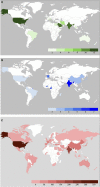An old confusion: Entomophthoromycosis versus mucormycosis and their main differences
- PMID: 36406416
- PMCID: PMC9670544
- DOI: 10.3389/fmicb.2022.1035100
An old confusion: Entomophthoromycosis versus mucormycosis and their main differences
Abstract
Fungal diseases were underestimated for many years. And the global burden of fungal infections is substantial and has increased in recent years. Invasive fungal infections have been linked to several risk factors in humans which basically depend on the individual homeostasis of the patients. However, many fungi can infect even apparently healthy people. Knowledge of these pathogens is critical in reducing or stopping morbidity and/or mortality statistics due to fungal pathogens. Successful therapeutic strategies rely on rapid diagnosis of the causative fungal agent and the underlying disease. However, the terminology of the diseases was updated to existing phylogenetic classifications and led to confusion in the definition of mucormycosis, conidiobolomycosis, and basidiobolomycosis, which were previously grouped under the now-uncommon term zygomycosis. Therefore, the ecological, taxonomic, clinical, and diagnostic differences are addressed to optimize the understanding and definition of these diseases. The term "coenocytic hyphomycosis" is proposed to summarize all fungal infections caused by Mucorales and species of Basidiobolus and Conidiobolus.
Keywords: basidiobolomycosis; conidiobolomycosis; entomophthoramycosis; mucoralomycosis; phycomycosis; zygomycosis.
Copyright © 2022 Acosta-España and Voigt.
Conflict of interest statement
The authors declare that the research was conducted in the absence of any commercial or financial relationships that could be construed as a potential conflict of interest.
Figures



References
-
- Alanio A., Garcia-Hermoso D., Mercier-Delarue S., Lanternier F., Gits-Muselli M., Menotti J., et al. (2015). Molecular identification of Mucorales in human tissues: Contribution of PCR electrospray-ionization mass spectrometry. Clin. Microbiol. Infect. 21 594.e1–5. 10.1016/J.CMI.2015.01.017 - DOI - PubMed
Publication types
LinkOut - more resources
Full Text Sources

